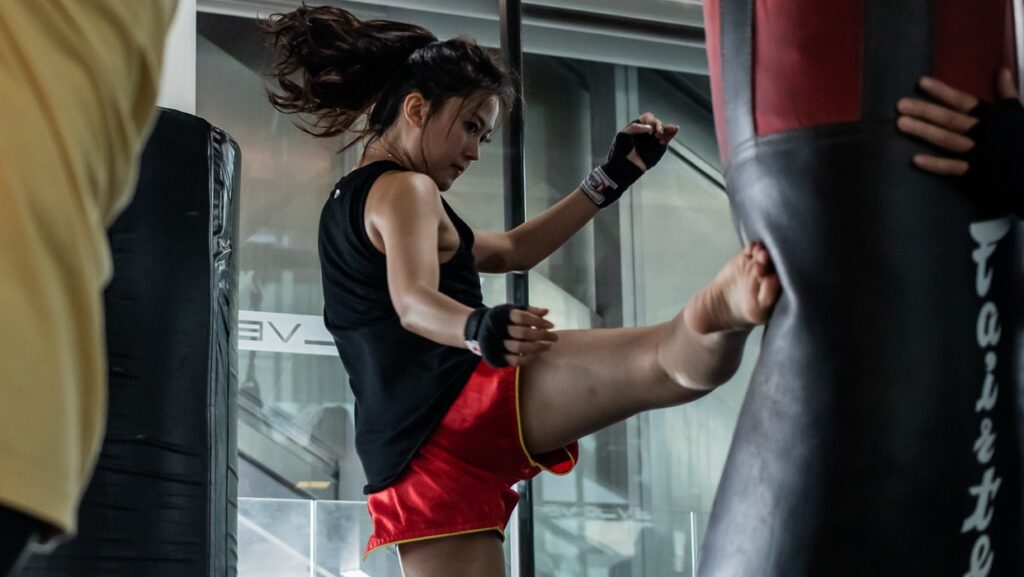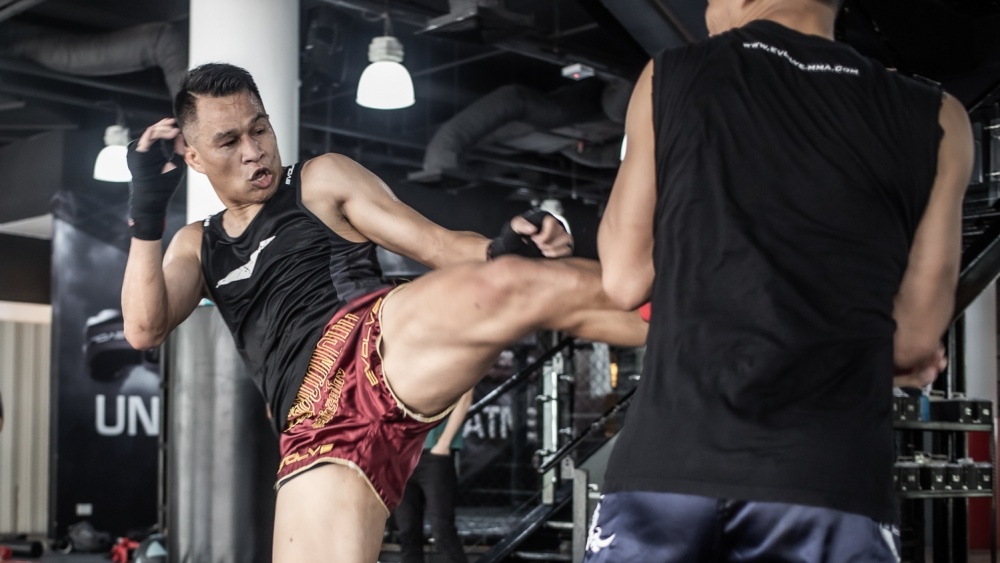Every Muay Thai beginner starts at the same place. Basic strikes are learned at a fundamental level, and details to those punches begin to emerge as intelligence within the sport develops and grows over time and with routine practice and repetition.
There are four Muay Thai punches you need to know and multiple variations of each punch to add some depth to your Muay Thai game. We’ll take a look at these four strikes, some ways to use them, and a few variations in placement and use to create a well-rounded approach to throwing punches – whether that happens to be on the bag, pads, or sparring.
1) The Jab
The jab is typically the absolute first punch all Muay Thai athletes learn. It is a highly recruited punch, finding itself involved in a variety of uses, including setting up other punches, creating space, preoccupying an opponent’s inside space and line of sight, and the punch with the furthest reach from your natural stance. It’s no surprise that it’s the first punch athletes learn, and its versatility is unmatched.
How To Use The Jab
- Setting Up Other Punches: The jab is a natural leader in setting up punches. Combinations following the jab are plentiful and effective. Start with the jab and utilize your other strikes (both upper and lower body) to follow up.
- Creating Space: The jab is excellent at creating space. Double or triple up the jab as you cut the corner on an opponent, giving yourself the angle and more space to follow up with kicks, sweeps, or other strikes.
- Preoccupy The Opponent’s Inside Space: Try utilizing the jab to dominate some inside space and block the line of vision of your opponent. Floating the jab in your opponent’s face after throwing the jab is an easy way to do this.
Variations Of The Jab
- Body Jab: Jabbing to the body is an excellent way to change up the use of the jab, put your opponent on the defense, and change levels. Level changes from the body jab lend well to follow-up jabs to the face, as well as opens the door to other strikes.
- Switch Jab: The switch jab is a play on footwork. To utilize this variation, throw the jab while you switch stances (you can follow up by fully stepping into the cross).
2) The Cross
The cross packs a ton of power as it stems from the rotation of your hip on your power side. It’s an excellent follow-up punch to the jab, making it an integral part of one of the first combos new students typically learn (jab-cross-hook). Use it to land heavy strikes or set up follow-up shots.
How To Use The Cross
- Follow-Up To The Jab: Utilizing the cross as a follow-up to the jab can lead to many creative combinations, or even just give you a solid finish to your combination.
- Power Shots: The cross packs a ton of power. It makes for an excellent finishing strike, and can certainly put your opponent on their heels.
Variations Of The Cross
- Body Cross: Once again, playing with the placement of this strike seems to change the strike up altogether. Change levels utilizing your legs to land this body shot. The level change of a body cross sets up solid uppercuts and body hooks, too.
3) The Hook
The hook is an excellent strike with a lot of room for variety. It is typically thrown at a closer range since it comes more from the side angle, packs a lot of power when it’s loaded properly from your hips, and provides a lot of great follow-up combinations.
How To Use The Hook
- Close Range: Once you’ve worked yourself into a close enough range to utilize the hook, you’ll find this strike amazingly effective. Utilize footwork or other punches to get yourself to a close enough range to make this strike effective.
- Power Shot: Try loading it off of a cross or body cross to set up the left hook as a power shot. When loaded well, this punch carries a lot of your weight behind it, making it a solid strike for all Muay Thai athletes.
Variations Of The Hook
- Left And Right: The left and right hook offer subtle differences in set-up that will give your partner different looks when you utilize them. Experiment with both to find your range (which varies due to your stance).
- Body Hook: Changing the level is yet again another way to change up this punch. Combinations or repeat hooks (i.e. body hook, head hook) are a great way to not only double up your punches but to change up the placement of your hooks. Aim for your opponent’s side and/or rib cage, or if you have the angle, aim right for their stomach as you load that punch through.
4) The Uppercut
The uppercut is notorious for those solid chin strikes. It fits seamlessly through an opponent’s high-guarded hands and manages to find its way around an opponent’s strikes as well. Use it in the inside space to defend against punches being thrown your way, set your opponent’s head back, or even just give some line-of-vision distraction.
How To Use The Uppercut
- Splitting The Guard: Use the uppercut to find your way through the bottom of your opponent’s guard. If their hands are set out from their face a bit, aim for the space between their elbows and straight up to their chin. From here, you’ll find many solid follow-ups as they quickly try to adjust to block that space out, revealing other openings for you to capitalize.
- Defense And Counter: Pair an uppercut with a slip. As you avoid a straight strike at your face, slip to the outside while you simultaneously throw the uppercut to the inside. Your opponent’s face will be open and susceptible to strikes since their hands are away from their face.
- Line Of Vision Distraction: Utilize the uppercut to distract your opponent’s line of vision. It’s a bit more challenging to see what’s going on when you are worried about protecting your chin from uppercuts; use that knowledge on the offensive side.
Variations Of The Uppercut
Placement: As with all the punches discussed so far, placement is key in changing up this strike. Placing your uppercut to the body vs. the chin will give you different follow-ups and open up new doors.
Master The Punches
Once you know and understand these four Muay Thai punches, as well as how to use them, change them up, and play with them, you’ll find yourself creating new and creative combinations with your striking that will work for you against any opponent or on any bag or pad workout.
You may also like:
















